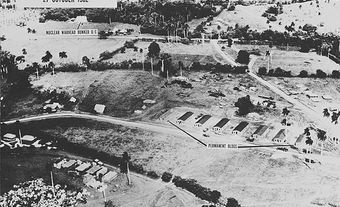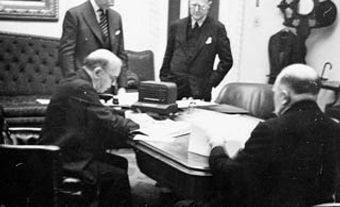Foreign aid is assistance from rich, industrialized countries to poorer, developing countries. Since the 1950s Canada has been distributing cash, goods and services to poorer nations around the world. In 2012 the federal government's foreign aid spending totalled $5.67 billion (2.5 per cent of all federal spending). There is considerable debate about both the effectiveness of foreign aid and whether it should be used for purely humanitarian purposes, for economic development purposes, or to further Canada's strategic and commercial interests abroad.
How it Started
Foreign aid has its roots in post-Second World War Reconstruction. The success of the Marshall Plan in channelling resources from the United States to war-torn Europe convinced Western leaders that a similar transfer of resources to newly independent countries in Asia and Africa would likewise lead to rapid development. Canada's aid program began in this period of prevailing optimism.
In 1950, Canada joined the Colombo Plan to support the recently independent Commonwealth countries of Asia. During the next two decades, Canada's program grew steadily, expanding to include the Commonwealth Caribbean (1958), Commonwealth Africa (1960) and francophone Africa (1961). In 1970, the program was extended to Latin America.
How it Evolved
In the 1960s, the government decided to raise levels of aid to other countries. In 1968, three significant events occurred:
First, the Canadian International Development Agency (CIDA) was created to administer Canada's aid efforts); second, Pierre Trudeau, a man with an abiding interest in international development, became prime minister; and third, former Prime Minister Lester Pearson headed an international commission to examine the results of 20 years' of development assistance, and to propose policies for improvement. The commission's report, Partners in Development, called for donor countries to provide foreign aid equal to 0.70 per cent of their Gross Domestic Product (GDP).
Canada accepted this target in 1970 and has repeatedly reaffirmed its commitment, but by 1986 had achieved aid spending of only 0.46 per cent of GDP. Canada never hit Pearson’s 0.70 per cent target but reached 0.50 per cent in 1987 under Prime Minister Brian Mulroney, according to a Library of Parliament report. That was followed by significant cuts to foreign aid in the 1990s, which reduced Canada's foreign aid spending to 0.25 per cent of GDP by 2000. In 2012 Canada's foreign aid spending was 0.31 per cent of GDP.
In 2013 the government of Prime Minister Stephen Harper merged CIDA into the new Department of Foreign Affairs, Trade and Development.
Government to Government Aid
In 2012 Canada's total aid spending of $5.67 billion was spread among 80 nations across the globe, and concentrated in about 20 countries. Ethiopia was the largest single recipient of Canadian aid, receiving $208 million, followed by Haiti ($205 million), Tanzania ($181 million) and Afghanistan ($163 million). Africa was the largest regional target in 2012, receiving 42 per cent of all Canadian aid that year, followed by Asia (22 per cent), and Latin America (17 per cent). Countries in Europe and other unspecified areas accounted for the rest.
Direct country-to-country (bilateral) aid accounted for about 13 per cent of Canadian aid spending in 2011. Bilateral aid to many countries, such as Sri Lanka, India and Pakistan is normally provided not in cash but in Canadian goods and services, including wheat and flour, railway locomotives and parts, equipment for hydroelectric generation and transmission, fertilizer, seeds and farm implements, and personnel to serve as advisers or instructors.
Multilateral aid, generally in cash, flows from Canada to many international quasi-government organizations, which undertake their own activities. Multilateral aid accounted for about 66 per cent of Canada's aid budget in 2011. The largest recipients were the World Bank and other multilateral development banks, and the specialized agencies of the United Nations such as the World Food Programme and the United Nations Children's Fund.
Aside from bilateral and multilateral spending, the remainder of Canada's foreign aid supports the International Development Research Centre — a crown corporation founded in 1970 to fund research on the needs of developing countries — and also dozens of Canadian non-governmental organizations in developing countries.
Non-Governmental Aid
Partly because of dissatisfaction with the results of government-to-government aid, industrialized countries have in recent decades allocated a share of their foreign aid to non-governmental organizations (NGOs). Churches and other charitable organizations have long provided voluntary aid to developing countries, but only in recent decades have governments funded the work of NGOs.
In 2011, about 21 per cent of the federal government's foreign aid spending was channelled through nearly 500 NGOs or "civil society" organizations, ranging from large groups such as Care Canada and the International Committee of the Red Cross, to smaller operations such as Handicap International Canada and Ryan's Well Foundation. In recent decades there has been a tremendous expansion in the number of NGOs, including not only the traditional voluntary aid agencies, but also colleges and universities, co-operatives, professional associations, and unions.
Early NGO activities stressed emergency relief and welfare activities, including the shipment of food and clothing and the sponsorship of children and families. While such activities remain important (and highly visible), emphasis is now more often placed on longer-term development work geared to promoting local self-reliance, and often implemented via NGOs in developing nations.
While most NGO projects remain small and community-based, some agencies are beginning to take on larger infrastructure and service-delivery programs. Most NGOs believe that educating Canadians about international development is an integral part of their work. Supporters of NGOs claim that they possess several advantages over official aid channels — speed, flexibility, lower costs, innovativeness and, above all, an ability to reach the poorest effectively.
As the scale and complexity of NGO programs increases, so do the expectations of NGO performance and the demands upon them to prove their worth. At the same time, many fear that as NGOs change from idealistic do-gooders to professional development organizations, they may come to ignore their ultimate source of strength: the building of links between Canadians and the citizens of developing countries.
What is Foreign Aid For?
The purpose and effectiveness of foreign aid are subjects of ongoing debate. There is still no completely shared view in donor countries about what aid should do, or how best to do it. Some people believe rich, Western nations should assist less developed countries in order to maintain friendly relations. Others view underdevelopment as a product of exploitation by more industrialized countries, and see generous aid as a kind of reparation.
The prevailing motivation for Canadian foreign aid is a humanitarian concern for the many millions of people who are obviously far poorer than most Canadians. Disparities in living standards are so great and so far beyond the control of poor people that many Canadians view the obligation to help as one of basic justice, rather than of charity. Humanitarianism, however, is never the only motive, particularly for government-to-government aid. When the Canadian government allocates official development assistance, it is also influenced somewhat by commercial interests (developing sales and future markets for Canadian products) and by political interests (the desire to build or maintain good relations with the recipient government).
Does Foreign Aid Work?
Even when the primary motive is humanitarianism, there are tensions between the need for short-term assistance to relieve hardship and longer-term help to enable poor people to become more self-sufficient. The latter approach became more widely accepted, especially with the emphasis since the mid-1970s on "basic human needs" development. But it is proving frustratingly difficult to achieve quick or impressive results with this kind of aid. Existing power structures in many developing countries are themselves a major obstacle to improvements for poor people, and some experts believe that official aid often reinforces these structures, rather than making them more responsive.
Observers who are skeptical of government intervention in economic life have also raised doubts about the potential effectiveness of official aid, which by necessity is channelled through recipient governments. Critics such as Zambian economist Dambisa Moyo have argued that in Africa, aid creates harmful dependencies that hinder rather than help economic and political development. Others, such as experts with the North-South Institute, an independent think-tank, say that in the 1960s and 1970s, Western aid helped Asian countries such as Thailand, Malaysia, and South Korea develop their economies, raise their standards of living, and eventually become aid donors themselves, and that foreign aid has the potential to do the same for Africa.
In most developing countries, aid is a small part of total foreign investment and is concentrated where the private sector can rarely take a leading role. The success of foreign aid depends on the domestic efforts of developing countries and the whole range of other links between developed and developing nations.

 Share on Facebook
Share on Facebook Share on X
Share on X Share by Email
Share by Email Share on Google Classroom
Share on Google Classroom


